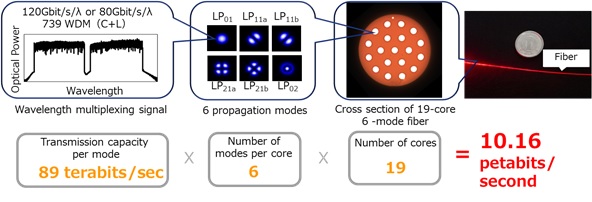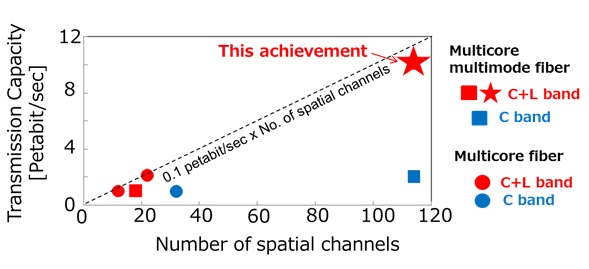 Print
Print
Success of ultra-high capacity optical fiber transmission breaking the world record by a factor of five and reaching a 10 Petabits per Second
~Transmission Rates of Ten Quadrillion, Contributing to the Technology that Supports Post-5G Mobile Communications~
September 22, 2017
KDDI Research, Inc.
Sumitomo Electric Industries, Ltd.
SAITAMA and OSAKA, JAPAN, September 22, 2017 -- KDDI Research Inc., and Sumitomo Electric Industries, Ltd., announced today that its success of ultra-high capacity optical fiber transmission experiment which has broken the world record of transmission capacity through a single optical fiber (2.15 petabits/second) and achieved 10.16 petabits/second (Note 1) with the multicore, multimode optical fiber (Note 2), which enables 114 space multiplicity. With the transmission capacity of 10 petabits/second, data for 25,000 Blu-ray disks (50 GB/both sides) can be transmitted in one second, or 100 million people can simultaneously communicate at 100 megabits. The mobile communication system after 5G requires innovations both in wireless technologies and in network and optical fiber transmission technologies that support them. Our new technology would be expected to be a key technology that will support broadband and a low latency mobile communications system after 5G and will provide new experiences and services.
[Background]
Future mobile communication systems require much higher capacity of optical fiber communication used in backhauls to provide a variety of services, such as IoT and connected devices, securely and safely. In conventional optical fiber ((single core) single mode fiber) communication systems, transmission capacity was expanded with multiple wavelength using wavelength division multiplexing technology. However, the transmission capacity is considered limited to at most about 0.1 petabits/second because of the limitation on the launched input power or interference between signals. In recent years, the space division multiplexing technology has been evolving worldwide that breaks through this limitation. This technology includes a multicore fiber containing multiple cores in an optical fiber and multimode fiber using multiple transmission modes. A report showed that capacity was expanded up to 2.15 petabits/second using 22-core fiber that enables 22 spatial multiplicity (Note 3).
[Achievements]
Although the conventional multicore, multimode optical fibers with more than 100 spatial multiplicity had achieved a transmission capacity of 2 petabits/second (Note 4), the maximum transmission capacity of 10 petabits/second, estimated from (0.1 petabits/second) x spatial multiplicity (100 or more), had not been achieved. In this experiment, Sumitomo Electric developed a performance-improved multicore, multimode optical fiber (Note 5), and KDDI Research provided signals to actually evaluate 10-petabit transmission and then evaluated the transmission characteristics with efficient approach to evaluate all the channels, achieving 10.16 petabits/second transmission over 11.3 km.
This experiment demonstrated the feasibility of ultra-high capacity optical communication systems of more than 10 petabits/second using multicore, multimode optical fibers. We will contribute to the development of the optical fiber transmission technologies for future versatile and large capacity data communication including 5G mobile system while assessing the range of applicability of multicore and multimode fibers.
This achievement was reported as a post-deadline paper (Note 6) for the European Conference on Optical Communications (ECOC) 2017, which is the largest international conference in Europe on the optical communication technology, held from September 17 to 21 in Gothenburg, Sweden.
Part of this research is based on the results of the research and development for practical use of innovative optical fibers (i-FREE2) (FY 2013 to FY 2017) at the National Institute of Information and Communications Technology (NICT).

Figure 1 Overview of multicore, multimode optical fiber transmission in this experiment

Figure 2 Comparison between past experimental results and achievement in this experiment
<Reference/Glossary of terms>
(Note 1) world’s highest transmission capacity of 10.16 petabits/second
In this experiment, we used 739 wavelength division multiplexed signals modulated at the symbol speed of 12 gigabaud with 64QAM (144 gigabits/second) or 16QAM (96 gigabits/second), and signals were polarization division multiplexed and space division multiplexed using 114 optical paths (6-mode and 19-core fiber). With three types of forward error correction codes with 25.5%, 20%, and 12.75% overhead assumed, the total transmission capacity of 10.16 petabits/second was achieved. Ten petas is equal to 10 quadrillion (10 to the 16th power). Ten petabits (P)/second = 10,000 teras (T) = 10,000,000 gigas (G).
(Note 2) multicore, multimode optical fiber with 100 or more space multiplicity
This optical fiber can use both multicore and multimode fiber transmission methods. To multiplex different signals, the multicore method uses multiple cores provided in a single optical fiber, and the multimode method uses multiple transmission modes in each core. For this optical fiber, the result of multiplication (= spatial multiplex count) between number of cores and the number of modes exceeds 100. In this experiment, an optical fiber with 19 cores and 6 modes was used (114 spatial multiplex).
(Note 3) research and development example of transmission at 2.15 petabits per second
(Note 4) research and development example of transmission at 2 petabits per second using a multicore, multimode optical fiber
Press release on October 1, 2015, “KDDI R&D Laboratories Achieves Ultra-High-Speed Data Transmission of 2 Pbps over Optical Fiber Approximately Double the World’s Previous Maximum Data Transmission Capacity”
(Note 5) Improvement of the performance of optical fibers
Compared with the conventional multicore, multimode optical fibers with more than 100 spatial multiplicity optimized for the C-band, we reduced the differences in transmission loss and signal delays between modes in the expanded bandwidth of the C+L band. We also increased the spatial density by minimizing the glass diameter and reducing the inter-core crosstalk to less than -50 dB.
(Note 6) post-deadline paper
This is a research paper that is accepted after the deadline for submission of general papers (post-deadline). Screening of post-deadline papers is conducted during the conference period, and only highly evaluated research achievements are given the opportunity of being reported.
※The information contained in the articles is current at the time of publication.Products, service fees, service content and specifications, contact information, and other details are subject to change without notice.